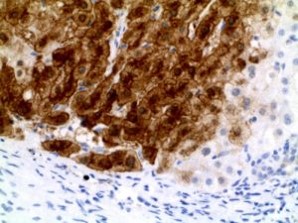
Glutamine synthetase by IHC-12376 - Technical only, 12379 - Technical & interpretation
Test info
Glutamine synthetase by IHC
12376 - Technical only, 12379 - Technical & interpretation
LAB12376
LAB12379
LAB12379
GS
All IHC stains will include a positive control tissue
- In normal liver, GS is present in the centrilobular regions of the liver, usually around the central veins
- In FNH of the liver, GS is present in large groups of hepatocytes, in an anastomosing pattern, typically around hepatic veins (referred to as a geographic or "map-like" pattern)
- HA show no staining, focal staining of hepatocytes around central veins, or patchy staining at the periphery (non-uniform and non-intense)
- Diffuse GS staining is seen in 13-70% of early hepatocellular carcinomas (HCC)
- High-grade dysplastic nodules (HGDN) are either GS negative, or show patchy positive staining for GS
Specimen
Tissue
Submit a formalin-fixed, paraffin-embedded tissue
Formalin-fixed, paraffin-embedded (FFPE) tissue block
FFPE tissue section mounted on a charged, unstained slide
Ambient (preferred)
- Unlabeled/mislabeled block
- Insufficient tissue
- Slides broken beyond repair
Performance
AHL - Immunohistochemistry
Mo - Fr
1 - 2 days
Immunohistochemical staining and microscopic examination
Clinical and Interpretive info
If requested, an interpretive report will be provided
Specifications
- Glutamine synthetase (GS) is an enzyme that converts glutamate and ammonia to glutamine
- GS can be used in a panel with serum amyloid A and beta catenin to help differentiate between hepatic adenomas (HA) and focal nodular hyperplasia (FNH)
Staining pattern
- Strong cytoplasmic staining
References
- Shafizadeh N et al: Diagnosis of well-differentiated hepatocellular lesions: role of immunohistochemistry and other ancillary techniques. Adv Anat Pathol 2011;18:438-445).
- Joseph NM et al: Diagnostic utility and limitations of glutamine synthetase and serum amyloid-associated protein immunohistochemistry in the distinction of focal nodular hyperplasia and inflammatory hepatocellular adenoma. Modern Pathology (2014) 27, 62-72; doi:10.1038/modpathol.2013.114.
Billing
88342 - 1st stain
88341 - each additional stain
88341 - each additional stain
Tracking
07/03/2017
10/18/2018
01/12/2024
